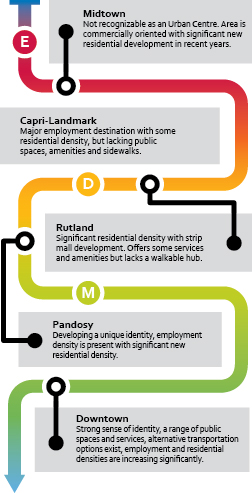Why invest in Urban Centres?
Urban Centres support the city’s greatest concentration and range of land uses - from residential to offices, retail to restaurants, schools and parks. Our Urban Centres have the future land use and zoning to accommodate over 40 per cent of Kelowna’s future residential growth in the coming decades.
These areas are also signaled as major nodes of employment, transit, shopping, and broad mix of activities. Thriving Urban Centres aim to ensure that these places are where work, live and combine to offer high quality of life – with lower infrastructure costs and less environmental and climate-related impacts compared to suburban sprawl.
Urban Centre Trends

Read the report for the similarities and differences
on each Urban Centre. Some overall highlights include:
- Urban Centres are
positioned for continued growth. Nearly 47 per cent of all residential
units issued a building permit between 2021 and 2024 were in
Urban Centres. Analysis demonstrates that Urban Centres will continue to be areas of significant
residential growth in the coming decades.
- Urban Centres are
significant hubs for employment. Over 40 per cent of all Kelowna daytime workers
(who work at a fixed location) are employed in Urban Centres.
- Urban Centres have gaps
in access to support daily needs. Urban Centres do not currently provide consistent access to all daily necessities (such
as work, schools, daycare, groceries, recreation and social and cultural necessities) to support
those who live, work and visit.
- Urban Centres travel
habits are different. Urban Centres have more infrastructure to support walking,
cycling and transit, and as a result these areas see a higher percentage
of people using these modes.
- Urban
Centre households are less affluent. The median
household income in Urban Centres is nearly 23 per cent lower than the citywide median but with the ability to be to be less
reliant on vehicles Urban Centres can be a more affordable option than their suburban
counterparts.
- Urban Centres need more
trees With extensive pavement and developed surfaces, our Urban Centres are more
susceptible to urban heat island effects, however have lower tree canopy
coverage than the rest of the community and some lack park and green
space.
- Urban Centres are influenced by adjacent growth. Future Urban Centre planning will need to explore the areas just outside Urban Centre boundarie, along withlarger corridors since Urban Centres will be influenced by new provincial housing legislation, new City plans and initiatives, and development applications that are adjacent to Urban Centres.
Did you know?
Project Outcomes
The Thriving Urban Centres project will be used to inform future action for Urban Centres, with a focus on tools that can help the City respond to the evolving growth context of each of these dynamic neighbourhoods.
